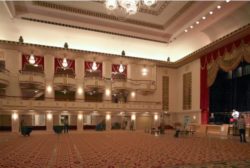
The Grand Ballroom of the Waldorf-Astoria Hotel. Image Credit: LPC.
Interior landmark is composed of contiguous spaces over three floors, including the Main Lobby and Grand Ballroom. The Landmarks Preservation Commission voted to designate the Waldorf-Astoria Hotel Interiors at its meeting on March 7, 2017. The exterior of the Hotel, at 301 Park Avenue in Manhattan, has been an individual City landmark since 1993. The hotel was purchased by Chinese investment firm Anbang in 2014. Anbang has closed the hotel for renovation, and intends to partially convert the building to condominium use.
Architect Lloyd Morgan, a partner at the firm Schultze and Weaver, led the design of the sumptuous Modern Classical and Art Deco hotel interiors. The designation is composed of multiple contiguous spaces over three floors. At the ground floor are the Park Avenue Foyer, decorated with 23 murals and a floor mosaic, the Main Lobby, with wood paneling and black marble pillars, a bank of elevators with metal doors and double staircases leading to the third floor. The Silver Gallery, a mirrored hallway linking four ballrooms with mosaic floors, occupies the third floor, as does the Basildon Room, with wall and ceiling panels salvaged from an 18th century British mansion. The designation also includes the Grand Ballroom, an iconic event space that hosts the annual Alfred E. Smith dinner, among other occasions. Connecting spaces between the rooms are incorporated into the landmark.
The Research Department’s Matt Postal noted that the Waldorf-Astoria and the landmarked Plaza Hotel with its Renaissance Revival Interiors were the only two major early-20th-century hotels in New York to retain their historic interiors.
Landmarks held a hearing on the potential designation on January 24, 2017. No representatives of Anbang testified at the hearing, but the firm said designation is consistent with their vision for the hotel, and cooperated with Landmarks staff in researching the interiors. Preservation advocacy organizations and local elected officials also supported designation.
At the March meeting, Chair Meenakshi Srinivasan called designation “vital, imperative and timely.” She said the designation would protect the “essence of what makes the hotel distinct” while preserving the “procession” of historic spaces. Commissioner Fred Bland noted that the hotel featured prominently in Rem Koolhaas’s book “Delirious New York,” and said he often encouraged his architecture students to visit it. Commissioner John Gustafsson commended the agency’s staff for securing the cooperation of the property’s owners, and said the spaces were some that “we all remember and appreciate.”
Commissioners voted unanimously to designate the spaces as the City’s 119th interior landmark.
LPC: Waldorf-Astoria Hotel Interiors, 301 Park Avenue, Manhattan (LP-2591) (March 7, 2017).

